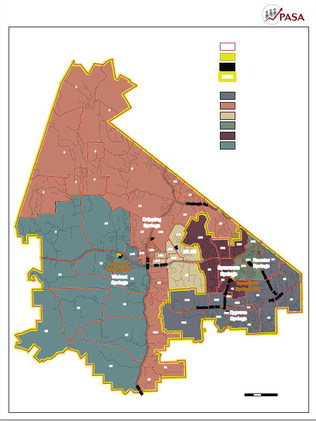DRIPPING SPRINGS — Approximately a month after the first reading, the Dripping Springs ISD Board of Trustees approved the new elementary and middle school attendance zones that will go into effect for the 2025-26 school year at its Dec. 16 meeting.
The new attendance zones follow the district working to construct its new elementary school (Elementary #6) in the Headwaters neighborhood, as well as expanding Sycamore Springs Middle School (SSMS) from an 850 to a 1,200 student capacity.
According to DSISD, the new elementary attendance zones will balance campus enrollments districtwide to relieve overcrowding at Dripping Springs and Walnut Springs elementary schools and add more students to the underenrolled elementary campuses on the east side of the district (Cypress Springs, Rooster Springs and Sycamore Springs). The new middle school zones will add more students to the SSMS campus, as the Dripping Springs Middle School attendance is projected to grow.
In August 2024, DSISD formed an Attendance Zoning Committee composed of parents, staff and community members to recommend new attendance zone boundaries. DSISD also collected input through two Google surveys and six community input sessions.
According to Superintendent Dr. Holly Morris-Kuentz, the committee's goal was to reorganize the elementary and middle school attendance zones to ensure, to the extent possible, that the following parameters are met:
• Optimize the utilization of district facilities while relieving overcrowded campuses
• Work to defer the timing of future school construction where possible
• Consider proximity and, to the extent possible, keep subdivisions together and zone students to the closest campus
• Strive to minimize the number of times a student is rezoned by considering future zoning changes as attendance zones are developed As a component of the attendance zoning, the district will establish a grandfathering process to allow certain students who are being rezoned the opportunity to continue at their current campus.
“Once we can get through and figure out our final map, that gives us the ability to move into the second phase, which is grandfathering,” said Morris-Kuentz. “So, grandfathering allows us to look at the number of students who are being rezoned and then, to provide opportunities for some of those students to remain at their currently zoned campus.”

Based upon the current map with no changes, Morris-Kuentz said she anticipates that rising third and fourth graders will be able to continue at their elementary school for fourth and fifth grade and rising sixth and seventh graders will be able to continue at their middle school for seventh and eighth grade. However, additional changes may prevent the addition of the second grade level and allow only incoming fifth and eighth graders to continue on at their current campus.
Leading into the board discussion, trustee Rob McClelland pointed out three things that were important to him during the attendance rezoning process: balance elementary and middle school enrollment with a low-average growth forecast through 2028-29; minimize relocation of existing families; and generous grandfathering options for the students.
“What I would ask the administration to do, as we look to rezone and get this done, is let’s overdo it on the integration process and the simulation process for these families that are moving. I would love to hear back from these parents in the spring that, ‘Man, it didn’t go the way we were hoping, but man, we feel good about where we are going,’” McClelland explained. “That’s at the campus level. That’s at the district level. And that’s even with us at the board level. Ensuring that we’ve done everything we can to mitigate what’s ultimately going to be a scenario where not everybody is getting exactly what they were hoping for out of the rezoning process.”
Another trustee, Shanda DeLeon said that in the future, when the board has to go through another rezoning process — as that could very well be a reality, the trustee explained — it needs to look at how to improve from this time around.
“Emotions started to play a bigger role in the end of that. I was sitting in the meeting, Mary Jane [Hetrick] was sitting there. There was a lot of emotional decision making, I think, in this final outcome of this map. So, that bothers me a little. I think there are a couple of things in this map where we are kicking the can, so to speak, that there could have been some other moves to make and we said, ‘No, we will wait until next time to make that,’” DeLeon said. “I just think next time we do it, we have got to consider things like that. I mean, we can’t go back and repeat the committee process right now.”
DeLeon added that it would have been helpful for the board to have a full workshop where the trustees could sit down and go through the different maps, documents, etc., as she believes that she and trustee Hetrick — who both served on the committee as ex-officio board members — had more information than the rest of the board.
She concluded that, while the board’s role is to make the decision that is best for the community, she said that she will “stand firm to my thought that this is not the best map for the community at this iteration of it.”
What’s key for trustee Kim Cousins is balance in all of the buildings: “These buildings aren’t cheap. They are very expensive and I want to see us fill up all of these buildings. When I look at the maps and when I look at the numbers at Rooster [Springs Elementary] and the numbers at Sycamore Springs Elementary, we have to continue to look at ways to put more students in those two buildings because they are great buildings.”
Cousins shared that at one of the most recent visits as a board to a campus, the trustees talked with some student leaders from varying grade levels. They explained that DSISD is doing a rezoning process and asked what the leaders would do if new students had to go to their school.
“They didn’t even hesitate. They looked at us and said, ‘You know what? We are going to welcome them with open arms. We are going to greet them at the front door. We are going to include them in things and we are going to do our very, very best to reach out.’ I think that’s what all of our schools are going to do,” Cousins said. “That’s probably, of this entire process, the most important thing I’ve heard in the last year and a half. And that’s the most important thing to me.”
Hetrick explained that throughout this process, there were competing values from different individuals on what they viewed to be important. She also added that this is a first to bring in a community committee for this process and the downside of that is that everybody is human, with varying viewpoints.
“I look at this map and I see faces of people all over this map. Many of whom are not happy right now and it’s really kind of soul crushing. It’s hard. You want to make everybody happy. There are some who go to my church and so, I see them every Sunday,” Hetrick said. “But it’s my job to step back and look at, did administration do the job that we tasked [Morris-Kuentz] and her team with doing? Yes. If we had a board workshop … to me, that feels like somewhere to overriding the naming committee. If we are going to override our community committees, then we shouldn’t have them, I guess, this is where I land on that.”
Morris-Kuentz said that the district told the committee from the beginning that there is never going to be a perfect map. It’s statistically impossible to create a map that does all of the things asked and comes out so that everybody is happy, the superintendent said.
In a 5-2 vote, with DeLeon and trustee Tricia Quintero dissenting, the board voted to approve the new attendance zones.
Important dates to note are listed below:
• School attendance boundaries will be published in January 2025
• Grandfathering guidelines will be announced in January 2025
• Grandfathering applications will open in the spring of 2025
• All boundaries will take effect in August 2025 The full discussion from the Dec. 16 meeting can be found at www.dsisdtx.us/page/board-meetinglivestream.
To learn more about the DSISD attendance zoning process, visit www.dsisdtx.us/o/dsisd/ page/attendance-zoning. More information about Elementary #6 can be found at www.dsisdtx.us/o/ dsisd/page/elementary-6 and more information about the SSMS expansion can be found at www. dsisdtx.us/o/dsisd/page/ssms-expansion.











